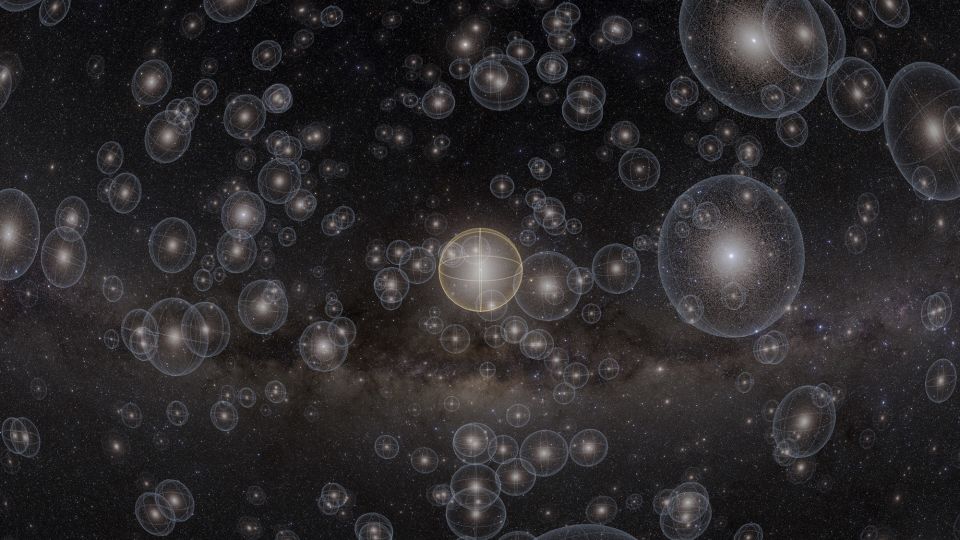An accidental discovery might change how we think about one of the most mysterious structures in our solar system.
The Oort Cloud, a large expanse of icy bodies revolving around the sun at a distance 1,000 times greater than the orbit of Neptune, is widely thought to be spherical — although it has never been directly observed.
But during the preproduction of a show titled “Encounters in the Milky Way,” which debuted Monday at the Hayden Planetarium in New York City, a projection on the planetarium’s dome revealed something strange within the Oort Cloud: a spiral.
The curators were testing out a scene in September that includes a detailed view of Earth’s celestial neighborhood — from the sun to the solar system’s outer edges — and were surprised when they saw the structure, which looked coincidentally similar to a spiral galaxy such as our own.
“We hit play on the scene, and immediately we saw it. It was just there,” recalled Jackie Faherty, an astrophysicist at the American Museum of Natural History and the curator of the show. “I was confused and thought that was super weird. I didn’t know if it was an artifact, I didn’t know if it was real.”
To investigate, Faherty got in touch with David Nesvorny, an institute scientist with the Southwest Research Institute in Boulder, Colorado, and the Oort Cloud expert who had provided scientific data for the scene.
“We didn’t create it — David did,” Faherty said. “This is David’s simulation, and it’s grounded in physics. It has a totally good physical explanation for why it should be there.”
At first, Nesvorny suspected artifacts — abnormalities or distortions in the data visualization — but once he looked at his data, he confirmed the presence of the spiral and eventually published a scientific paper about the discovery in April in The Astrophysical Journal. “Weird way to discover things,” he said. “I should know my data better, after years of working with it.”
Crazy, long orbits
The existence of the Oort Cloud was first proposed in 1950 by Dutch astronomer Jan Oort, who imagined it as a shell of icy bodies swirling around the sun from up to 1.5 light-years away. The cloud is the most distant region in our solar system, stretching as much as halfway to the next star, according to NASA.
It’s composed of leftovers from the making of our solar system, which were scattered in every direction by the planets after they formed. That means many of the icy bodies in the Oort Cloud don’t share the same orbital plane as the solar system itself but travel at various inclinations, which is why the Oort Cloud is pictured as a sphere. If one of those icy bodies gets flung inward toward the sun, the heat starts vaporizing some of the material in the body, creating a tail — and what we call a comet.
“Every now and again, some of these icy bodies come into the inner solar system, and we can see the orbit that they’re on,” Faherty said. “And they’re on these really crazy, long orbits. It can take them millions of years to go around the sun. And when they come in, they help us understand how far away they may have come from.”
The problem with trying to imagine what the Oort Cloud looks like is that scientists have never seen it, even though we are technically surrounded by it. That’s because the bodies that make it up are small — fewer than 60 miles (97 kilometers) in diameter — and even though they potentially number in the trillions, they are far away, making observations with telescopes difficult.
The spiral was hiding in Nesvorny’s data because he had never thought of visualizing it three-dimensionally. “I never looked at it in Cartesian coordinates — I didn’t have a good reason to do so,” he said. “But once you do that, it’s obvious. It’s there.”
The galactic tide
To confirm the findings, Nesvorny used one of the most powerful computers in the world, NASA’s Pleiades Supercomputer, to run simulations that took weeks to complete.
“I thought, maybe just this particular simulation (I gave the planetarium) is showing it, and all the other simulations with other stellar encounters, other parameters, will not show it, in which case it wouldn’t be so interesting,” he said. “But all the simulations, all the models I have, show the spiral.”
The reason it’s there, he said, is that objects in the Oort Cloud are far away enough from the sun’s gravity that they also start being affected by the galactic tide — the gravitational field of our galaxy, exerted by the stars and the dark matter in it. This field is acting on the small bodies and comets in the Oort Cloud by twisting their orbital planes to create a spiral.
The spiral, Nesvorny added, is in the inner part of the Oort Cloud, the closest to us, and he still believes that the outer portion is spherical or shell-shaped.
The problem of observing the Oort Cloud remains, even though the Vera C. Rubin Observatory, a powerful telescope that recently came online in Chile, could offer a hand by discovering and observing individual icy bodies in the cloud. However, according to Nesvorny, the telescope will likely discover dozens of these bodies — not the hundreds that would be required to produce a meaningful visualization of the spiral.
The spiral theory helps to illuminate the dynamics of our solar system, according to Faherty. “If you’re going to come up with a theory of how solar systems evolve, you should take into account the kind of shapes you might have in their structure,” she said. “Maybe comets helped deliver water to Earth. Maybe the building blocks of life could be out there in the Oort Cloud, so if you want to talk about the potential building blocks of life that surround our solar system, you need to understand its shape.”
It’s a “dream,” she added, to be able to present science so recent in a show aimed at the general public. “I truly believe that the planetarium, the dome itself, is a research tool,” Faherty said. “I like to say that this is science that hasn’t had time to reach your textbook yet.”
Viewing what’s not visible
The spiral finding is a wonderful example of just how much we can learn through visualizing the universe in new ways, said Malena Rice, an assistant professor of astronomy at Yale University who did not participate in the study.
“This result reshapes our mental image of our home solar system, while also providing a new sense for what extrasolar systems’ Oort clouds may look like,” Rice added. “It unites our models of the solar system with what we know about the broader galaxy, placing it into context as a dynamic system. We are not static, and we are not isolated — our solar system is shaped by its broader ecosystem, and the Oort spiral exemplifies that.”
While the paper is interesting, it is almost entirely theoretical, as it is based on numerical simulations of the interactions between the sun’s gravity and the gravitational pull of the rest of the Milky Way galaxy’s motion, said Edward Gomez, an astrophysicist and honorary lecturer at Cardiff University in the UK. He also was not involved with the study.
“Long period comets enter the inner solar system at a range of angles, which the authors try to model using their spiral arm idea,” Gomez said in an email. “What they are proposing could be true, but it could also be modelled by other shapes of the Oort cloud or physical processes. How to test this is their major issue, because only a handful of potential Oort cloud objects are known about.”
Confirming the findings will be a challenge, noted Simon Portegies Zwart, a professor of numerical star dynamics at Leiden University in the Netherlands who was not part of the team behind the research. “It is interesting that they found the spiral, (but) it seems unlikely that we are going to witness (it) in the foreseeable future,” he said.
With luck, he added, the Vera Rubin observatory will detect a few hundred inner Oort Cloud objects, but the spiral would only be visible if many more are found: “It therefore seems unlikely to be a clearly detectable structure.”
For more CNN news and newsletters create an account at CNN.com
The post Accidental find in planetarium show could shift scientists’ understanding of our solar system appeared first on CNN.




